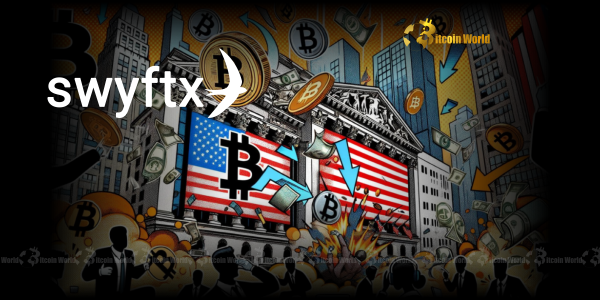BitcoinWorld

Binance Stablecoin Reserves: Unrivaled Dominance on Centralized Exchanges
In the ever-evolving world of cryptocurrency, understanding where liquidity resides is crucial. A recent revelation from Binance CEO Richard Teng, citing data from CryptoQuant, shines a spotlight on the massive concentration of Binance stablecoin reserves within the centralized exchange ecosystem. According to Teng, Binance holds a staggering 59% of all stablecoin reserves across Centralized Exchanges (CEXs), amounting to approximately $31 billion. This figure underscores Binance’s significant position and its potential influence on the broader stablecoin market.
What Exactly Are Stablecoin Reserves?
Before diving deeper into Binance’s dominance, let’s quickly define what we’re talking about. Stablecoins are cryptocurrencies designed to maintain a stable value, usually pegged to a fiat currency like the US dollar. This stability makes them essential for trading, yield farming, and acting as a safe haven during market volatility.
Stablecoin reserves held by exchanges are the total amount of stablecoins users have deposited onto these platforms. These reserves are vital for facilitating trading pairs (like BTC/USDT, ETH/USDC), providing liquidity, and enabling users to easily enter and exit positions without constantly converting back to traditional fiat currency.
Why Does Binance Hold Such a Massive Share? Exploring Binance Dominance
The figure of 59% of all Centralized Exchange stablecoins held by Binance is not just a number; it reflects the exchange’s immense scale and reach. Several factors likely contribute to this level of Binance dominance:
- Vast User Base: Binance boasts the largest user base among crypto exchanges globally. More users naturally mean higher deposits, including stablecoins.
- Extensive Trading Pairs: Binance offers an unparalleled number of trading pairs involving various stablecoins (USDT, USDC, BUSD – historically significant, etc.). This makes it the go-to platform for traders who rely heavily on stablecoin pairs for strategy execution.
- Deep Liquidity: High reserves contribute to deep liquidity across numerous markets on Binance, attracting both retail and institutional traders who prioritize minimal slippage.
- Global Presence: Despite regulatory challenges in specific regions, Binance maintains a strong global footprint, consolidating a large portion of worldwide crypto activity.
- Product Diversity: Beyond spot trading, Binance offers futures, options, staking, lending, and other products that heavily utilize stablecoins, encouraging users to keep reserves on the platform.
This concentration highlights Binance’s central role in the flow of stable value within the crypto ecosystem.
Understanding the Crypto Market Share Implications
Binance holding nearly 60% of all Centralized Exchange stablecoins has significant implications for the overall Crypto Market Share landscape. Here are a few key takeaways:
- Liquidity Hub: Binance acts as the primary liquidity hub for stablecoins, making it the most efficient place for large trades involving stable assets.
- Market Influence: The sheer volume of stablecoins on Binance means activity on the platform can heavily influence stablecoin prices and trading patterns across the market.
- Risk Concentration: While dominance indicates strength, it also presents a degree of risk concentration. Any significant event impacting Binance (e.g., regulatory action, technical issues) could have a ripple effect on a large portion of the stablecoin market.
- Competitive Landscape: This data point emphasizes the challenge faced by other CEXs in competing with Binance’s established network effect and liquidity advantage in the stablecoin arena.
For traders and investors, understanding this distribution is vital for assessing market dynamics and potential points of impact.
What Does This Mean for the Stablecoin Market?
The fact that $31 billion in Binance stablecoin reserves represents 59% of the total on CEXs tells us something important about the overall size and distribution of the Stablecoin market on these platforms. It suggests the total stablecoin reserves on all CEXs combined are somewhere in the range of $52-53 billion ($31B / 0.59). This figure is separate from stablecoins held in decentralized protocols, self-custody wallets, or other venues, but it highlights the significant volume anchored within centralized trading infrastructure.
The health and stability of these centralized reserves are paramount for market functioning. Binance’s large share means it bears a significant responsibility in managing these assets securely and transparently, a point often emphasized by exchanges in building user trust.
Challenges and Opportunities Arising from Centralized Exchange Stablecoins Concentration
While Binance dominance in stablecoin reserves offers benefits like deep liquidity, it also brings challenges:
- Challenges:
- Regulatory Scrutiny: Large concentrations of funds attract regulatory attention regarding compliance, KYC/AML, and potential market manipulation risks.
- Single Point of Failure: A major security breach or operational failure at Binance could disproportionately impact the centralized stablecoin market.
- Centralization Concerns: For proponents of decentralization, such high concentration on one platform runs counter to the core ethos of crypto.
- Opportunities:
- Enhanced Trading: Deep pools of Centralized Exchange stablecoins allow for efficient, large-volume trading.
- Price Stability: Concentrated liquidity can help stablecoins maintain their peg more effectively on the dominant platform.
- Innovation Hub: Binance can leverage its large stablecoin reserves to launch new products and services that require significant stablecoin liquidity.
Navigating these aspects is key for both the exchange and market participants.
Actionable Insights for Traders and Investors
Given the significant level of Binance stablecoin reserves and its resulting market influence, what should individuals in the crypto space consider?
- Monitor Binance Activity: Keep an eye on major announcements, regulatory news, or changes in policy related to Binance, as these could impact a large portion of the stablecoin market.
- Understand Liquidity: While Binance offers deep stablecoin liquidity, be aware of how liquidity is distributed across different stablecoin pairs and other exchanges.
- Diversify Exchange Use (Optional): Depending on your risk tolerance and trading needs, consider distributing funds across multiple reputable exchanges, although this comes with its own complexities.
- Stay Informed on Stablecoin Developments: Pay attention to regulatory developments surrounding stablecoins themselves, as these will affect their usage and reserves on all platforms, including Binance.
Understanding the landscape of Centralized Exchange stablecoins, particularly Binance’s role, is crucial for making informed decisions.
The Future of the Stablecoin Market and Binance’s Role
The Stablecoin market is constantly evolving, driven by technological advancements, increasing adoption, and evolving regulatory frameworks. Will Binance maintain its dominant Crypto Market Share in stablecoin reserves? Competition from other CEXs, the growth of decentralized finance (DeFi), and potential new regulations could shift the balance. However, Binance’s established network effect and liquidity advantage provide a strong foundation.
The reported $31 billion in Binance stablecoin reserves is a testament to the exchange’s current standing. As the market matures, transparency and regulatory compliance will become even more critical factors influencing where users choose to hold their stable assets.
Concluding Thoughts
Richard Teng’s statement, backed by CryptoQuant data, confirms Binance’s formidable position in the centralized stablecoin landscape. Holding 59% of Centralized Exchange stablecoins underscores its role as a critical liquidity provider and a significant force in the overall Stablecoin market. While this level of Binance dominance brings efficiency and liquidity, it also highlights the importance of understanding concentration risk within the Crypto Market Share distribution. As the industry moves forward, monitoring these dynamics will be essential for anyone participating in the crypto space.
To learn more about the latest crypto market trends, explore our article on key developments shaping the stablecoin market and institutional adoption.
This post Binance Stablecoin Reserves: Unrivaled Dominance on Centralized Exchanges first appeared on BitcoinWorld and is written by Editorial Team





